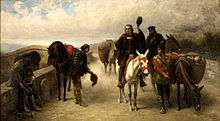A. G. Heaton
Augustus Goodyear Heaton (April 28, 1844 – October 11, 1930)[1] [2] was an American artist, author[3] and leading numismatist. He is best known for his painting The Recall of Columbus and among coin collectors for writing A Treatise on Coinage of the United States Branch Mints, which introduced numismatists to mint marks.
Biography
Personal life
Augustus Goodyear Heaton was born Augustus George Heaton[1][4][5] in Philadelphia on April 28, 1844, to Augustus and Rosabella (née Crean) Heaton.[1] Heaton married Adelaide Griswold in New York City on December 24, 1874, and had three children; Augustus (1875), Henry (1877) and Perry (1884)[1] before divorcing in 1898.[6] Heaton lived in various locations: New York City in the late 1870s; Paris, France in the early 1880s; Philadelphia (1884); Washington, D.C. (1885); and then West Palm Beach, Florida. In 1890, 1892 and 1930, he was in New Orleans where he gave art lectures and painted portraits of numerous prominent citizens.
Art
Heaton was a student at the Pennsylvania Academy of Fine Arts [7] with Peter F. Rothermel, and was the first American student at the École des Beaux-Arts in Paris[1] with Alexandre Cabenel[4] and Leon Bonnat. Heaton was also a teacher in Philadelphia at the Art Students League of New York.

Most of Heaton's paintings are portraits, including Varina Davis, second wife of President Jefferson Davis, known as First Lady of the Confederate States of America (1892), Sculptor Chauncey Ives (1883), Opera singer Emma Nevada and Bishop Thomas Bowman of Cornell College, Iowa. (1883).[4] His most famous painting, however, and the one of which he was most proud, was The Recall of Columbus, painted in 1882 and copyrighted in 1891 as the 400th anniversary of Christopher Columbus' landing approached. It was begun in his Paris studio and finished in Rome in the studio of American sculptor Chauncey Ives. The painting was sent to the U.S. Capitol in 1884 to be reviewed by the Joint Committee on the Library, purchased later that year for $3,000 and remains part of the United States Senate Art and History Collection. In 1892, the painting was exhibited at the Columbian Historical Exposition in Madrid in 1892 and again in 1893 at the World's Columbian Exposition in Chicago. Also in 1893, to mark the Chicago Exposition, was the release of the Columbian Issue, a set of 16 commemorative stamps issued by the United States.[8] The 50 cent stamp featured The Recall of Columbus[9] bringing the painting to the attention of the general public.
Heaton was one of the founding members of the New Rochelle Art Association, organized in 1912, and part of the well known Art Colony that had developed in New Rochelle in the early 1900s.[10]
Other works of note are The First Mission of Washington (1862), Columbia's Night Watch (1866), Bathing Hour at Trouville (1880) and The Promoters of the New Congressional Library (1888), which is a life sized group portrait composed of eighteen prominent statesmen.[4] His Hardships of Emigration was also placed on a stamp for the Omaha Fair in 1898.[5]
Numismatics
A. G. Heaton was the third president of the American Numismatic Association, governing from 1894 to 1899 .[11] In 1893, he published his famous Treatise on Coinage of the United States Branch Mints, which revolutionized numismatics. Until its publication, collectors generally only collected by date. Heaton's Treatise, commonly referred to as just Mint Marks, showed that the coinage of the branch mints was often significantly more scarce and hence worth far more. In 1900, Heaton updated Mint Marks in the article, Late Coinage of the United States Mint, published in The Numismatist.[12] Heaton was a frequent contributor to The Numismatist, submitting both articles and poetry, including The Numismatist and the Burglar, published by The Numismatist in 1894 and later appeared in Heaton's book, Fancies and Thoughts in Verse.[13] As a collector, he owned a complete collection of US $3 and $1 gold coins from all five mints where they were coined, one of only two such collections in existence.[4]
Publications and articles
- 1882 - Memories of Italy
- 1893 - A Treatise on Coinage of the United States Branch Mints
- 1895 - A Tour Among the Coin Dealers, appeared in The Numismatist
- 1900 - The Heart of David, The Psalmist King
- 1903 - Poems" by John Henry Boner (Illustrations by Heaton)
- 1903 - Stolen From a Duchy's Throne" by Leland Dolph Cox (Illustrations by Heaton)
- 1904 - Fancies and Thoughts in Verse
- 1906 - Yellowstone Letters
- 1915 - Study Rewarded
- 1925 - The Nutshell
- 1926 - The Marseillaise
- 1929 - Color; a Treatise: A Treatise
References
- Lewis Randolph Hamersly, et al., (1918). Who's Who in New York (City and State), p.500. Who's Who Publications, Inc., Washington, D.C.
- "Augustus Heaton, Noted Artist, Dead". The Washington Post. 1930-10-12. Retrieved 2009-03-07.
- "HEATON, Augustus George". The International Who's Who in the World: 587. 1912.
- Rossiter Johnson, John Howard Brown (1904). The Twentieth Century Biographical Dictionary of Notable Americans, p.216. The Biographical Society, Boston, Massachusetts
- The Encyclopedia Americana: a library of universal knowledge (1919), p.54
- "Heaton Sues for Divorce" (PDF). The New York Times. 1898-06-01. Retrieved 2009-03-07.
- ArtSchoolsDigital.com (2009). "Philadelphia Academy of the Fine Arts". Art Schools Digital. Archived from the original on 2008-11-06. Retrieved 2009-03-07.
- "The Recall of Columbus". The United States Senate. Archived from the original on 27 February 2009. Retrieved 2009-03-07.
- "Columbian Exposition Issues (1893)". Arago, People, Postage and the Post. Retrieved 2009-03-07.
- NRAA - Fouder's Exhibit; A. G. Heaton
- "ANA Presidents 1891 to the Present". American Numismatic Association. Archived from the original on 2011-06-14. Retrieved 2009-03-07.
- "Story of the 1894-S Dime". Coin Link. Archived from the original on 2007-11-23. Retrieved 2009-03-07.
- Augustus Goodyear Heaton (1904). Fancies and Thought in Verse, p.221. BiblioBazaar, LLC, Charleston, South Carolina, ISBN 0-559-83287-7, ISBN 978-0-559-83287-1
External links
| Wikimedia Commons has media related to A. G. Heaton. |